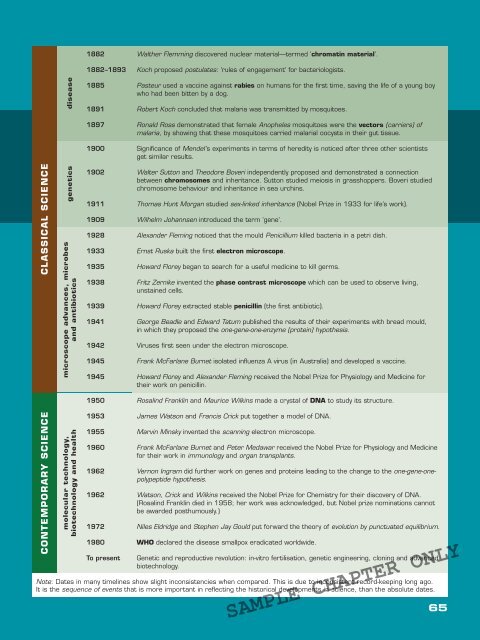BIOLOGY IN FOCUS
BIOLOGY IN FOCUS
BIOLOGY IN FOCUS
Create successful ePaper yourself
Turn your PDF publications into a flip-book with our unique Google optimized e-Paper software.
1882 Walther Flemming discovered nuclear material—termed ‘chromatin material’.<br />
1882–1893 Koch proposed postulates: ‘rules of engagement’ for bacteriologists.<br />
disease<br />
1885 Pasteur used a vaccine against rabies on humans for the first time, saving the life of a young boy<br />
who had been bitten by a dog.<br />
1891 Robert Koch concluded that malaria was transmitted by mosquitoes.<br />
1897 Ronald Ross demonstrated that female Anopheles mosquitoes were the vectors (carriers) of<br />
malaria, by showing that these mosquitoes carried malarial oocysts in their gut tissue.<br />
1900 Significance of Mendel ’s experiments in terms of heredity is noticed after three other scientists<br />
get similar results.<br />
CLASSICAL SCIENCE<br />
genetics<br />
microscope advances, microbes<br />
and antibiotics<br />
1902 Walter Sutton and Theodore Boveri independently proposed and demonstrated a connection<br />
between chromosomes and inheritance. Sutton studied meiosis in grasshoppers. Boveri studied<br />
chromosome behaviour and inheritance in sea urchins.<br />
1911 Thomas Hunt Morgan studied sex-linked inheritance (Nobel Prize in 1933 for life’s work).<br />
1909 Wilhelm Johannsen introduced the term ‘gene’.<br />
1928 Alexander Fleming noticed that the mould Penicillium killed bacteria in a petri dish.<br />
1933 Ernst Ruska built the first electron microscope.<br />
1935 Howard Florey began to search for a useful medicine to kill germs.<br />
1938 Fritz Zernike invented the phase contrast microscope which can be used to observe living,<br />
unstained cells.<br />
1939 Howard Florey extracted stable penicillin (the first antibiotic).<br />
1941 George Beadle and Edward Tatum published the results of their experiments with bread mould,<br />
in which they proposed the one-gene-one-enzyme (protein) hypothesis.<br />
1942 Viruses first seen under the electron microscope.<br />
1945 Frank McFarlane Burnet isolated influenza A virus (in Australia) and developed a vaccine.<br />
1945 Howard Florey and Alexander Fleming received the Nobel Prize for Physiology and Medicine for<br />
their work on penicillin.<br />
1950 Rosalind Franklin and Maurice Wilkins made a crystal of DNA to study its structure.<br />
CONTEMPORARY SCIENCE<br />
molecular technology,<br />
biotechnology and health<br />
1953 James Watson and Francis Crick put together a model of DNA.<br />
1955 Marvin Minsky invented the scanning electron microscope.<br />
1960 Frank McFarlane Burnet and Peter Medawar received the Nobel Prize for Physiology and Medicine<br />
for their work in immunology and organ transplants.<br />
1962 Vernon Ingram did further work on genes and proteins leading to the change to the one-gene-onepolypeptide<br />
hypothesis.<br />
1962 Watson, Crick and Wilkins received the Nobel Prize for Chemistry for their discovery of DNA.<br />
(Rosalind Franklin died in 1958; her work was acknowledged, but Nobel prize nominations cannot<br />
be awarded posthumously.)<br />
1972 Niles Eldridge and Stephen Jay Gould put forward the theory of evolution by punctuated equilibrium.<br />
1980 WHO declared the disease smallpox eradicated worldwide.<br />
To present<br />
Genetic and reproductive revolution: in-vitro fertilisation, genetic engineering, cloning and advanced<br />
biotechnology.<br />
Note: Dates in many timelines show slight inconsistencies when compared. This is due to inconsistent record-keeping long ago.<br />
It is the sequence of events that is more important in reflecting the historical developments in science, than the absolute dates.<br />
SAMPLE CHAPTER ONLY<br />
65
















